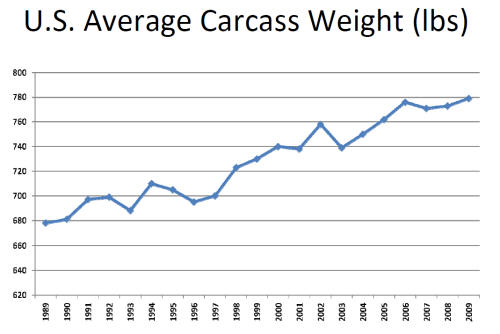



Developments In The US Beef Sector
Speaking at the English Beef and Lamb Executive annual conference in October, Nebraska beef industry professor, Dr Chris Calkins from the US, gave an update of developments in the US beef sector. Charlotte Johnston, TheCattleSite junior editor reports.
State of the US industry
"There have been some rather dramatic changes in our herd," said Dr Calkins. "The size of the US cow herd is low and continuing to fall - the cattle inventory is now at the same stage it was at in the 1960's."
There has been an increasing amount of heifers entering the feedlots, which has obviously had an effect on the US breeding herd.
Slaughter has also fallen since 2006, which has meant that US commercial beef production is falling. On top of this domestic beef demand is also dropping.
However, despite this negative news, there is some light at the end of the tunnel. Beef exports are strong and increasing, he said, stressing that the US very much values its export partners, including the EU.
Increasing carcase weights are a continuing challenge for the US industry. Over the last 20 years, carcase weights have continued to creep up, which means that cuts are getting larger and larger. This has meant that the marketing of beef to consumers has had to change.

US net imports of beef have fallen 12 per cent over the last six years and exports have increased by 20 per cent, with the EU and Asia been the major export markets.
The UN/ FAO has said that global food production will need to increase 70 per cent by 2050, which Dr Calkins pointed out is not very far away. Therefore productive capacity must continue to increase. He predicted that beef exports will grow by 2.8 million tonnes by 2018, which is the equivalent of 22 per cent of todays US beef production.
Muscle Profiling
With carcase weight increasing, Dr Calkins and his colleagues felt it was important to add value to each section of the carcase.
Research began in 1999, into the muscle profiling project, with the goal of looking at increasing the value of the chuck (shoulder) and the round (hindquarter), as well as creating an encyclopedia on muscles.
Dr Calkins started looking at beef primal price trends. Prices of chuck round and trimmings, which together contribute to 69 per cent of carcase weight, have fallen between 24-28 per cent. In total he found that 70 per cent of the carcase weight has fallen by 75 per cent in value.
With this information to hand, he asked where they could improve on the lost value.
Perhaps one of the causes of this lost value Dr Calkins suggested, was that processors have become lazy. Instead of looking at new or improved cutting methods they are happy to continue as they have been doing, selling chuck at a cheaper price. He points out that the chuck compromises of 15 muscles - all which have been undersold.
This, he explained, is why the muscle profiling project wanted to make a book of knowledge on muscles.
He continued to explain that muscle profiling is a comprehensive body of work that fully characterises the chuck and round, such as tenderness, composition, processing traits, dimensions and colour - as well as others.
Each carcase section profiled (chuck and round), contained 39 muscles. The profiling looked at 144 carcases and so a total of 5616 muscles.
The results flagged up three major muscles in the shoulder clod - these were developed into the flat iron streak, petite tenders and ranch steaks.
The research highlighted that the shoulder clod contained two muscles which are in the top 10 most tender muscles in the beef carcase - these muscles were previously being minced.
The Success Story
In the US, half of all beef produced is sold through the foodservice industry (restaurants).
In 2001, the flat iron steak was introduced and in 2009, 89 million pounds were sold, making the flat iron steak worth $499 million in the wholesale market. The ranch steak was introduced in the same year, and in 2009, 27 million pounds were sold at a value of $159 million.
The most recent introduction has been the Denver cut, whose popularity is slowly increasing.
"But has this research and these new cuts added value to beef?" asked Dr Calkins.
In total, new cuts have increased the wholesale value by $50-70 per head of cattle. This is a significant increase in the value of chuck, said Dr Calkins. It has certainly increased consumer demand for the product through the creation of new cuts . The research has also changed the way in which beef is cut in the US, consequently adding value.
Due to the global financial situation in the US, the foodservice market has suffered. Tenderloin is now worth 37 per cent less than it was in 2007, hence the need to offer a second tier/ alternative product such as chuck.
The research involved the whole industry, from producers, packers to culinary experts and consumers - which is why it was such a success. The research also identified the pectinous muscle from the top round, which when matured is more tender than the fillet, said Dr Calkins.
Beef Innovations
Recently, the beef innovations group launched the 'we have a muscle for you' campaign - which highlights to consumers the value of individual cuts for what is been cooked. The idea is to educate consumers into using the different cuts of meat for the relevant dishes.
Cutting guides and culinary fact sheets are all available on www.beefinnovationsgroup.com.
On-line Quality Measurements: Tenderness Matters
The research undertaken has shown that consumers are willing to pay a significant premium for guaranteed tender beef.
Previous studies in the US have shown that consumers in a grocery store setting would pay a $1.23 per pound premium , before tasting, for quality beef. After tasting, this added premium increased to $2.40 per pound.
The online quality measurement is a grading instrument, which focuses on marbling and tenderness.
Dr Calkins says that approximately 50 per cent of abattoirs in the US use this camera, which looks at marbling on the rib eye. If the tenderness of the rib eye can be vouched for - taking into account that rib eye is one of the least tender parts of the carcase, then the camera could guarantee 138 pounds of tender meat per carcase, Dr Calkins said.
He explained that the use of the camera removed human bias, which if used throughout all abattoirs would help standardise meat quality.
The USDA has put forward an agricultural marketing proposal to brand meat dependent on its tenderness. However, there is more research required before this is taken any further.
Conclusion
There are many challenges that the US beef industry is facing - the primary one being increasing carcase weight. Dr Calkins said that valuing individual muscles for tenderness is the way forward for the industry.
The ability to change the way meat is cut and presented to the consumer can add substantial value to the end product.


